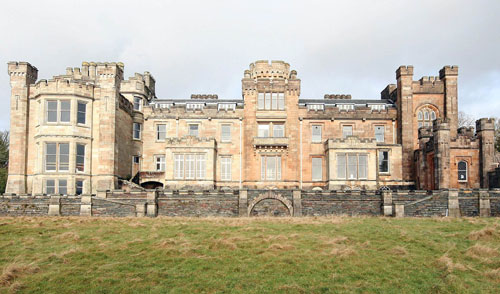A SCOTTISH castle which played a vital but little-known role in defeating Nazi Germany is on the market for £1.75m.
The buyer of 19th Century Castle Toward gets 25 bedrooms, six reception rooms and extensive grounds with stunning views over the Cowal peninsula near Dunoon.

But 73 years ago the property was commandeered by Winston Churchill, renamed HMS Brontosaurus, and used to train thousands of British troops for the D-Day landings.
Overlooking the Clyde estuary, and with easy access to the sloping shoreline, the castle was an ideal place to train troops in amphibious warfare.
Soldiers practised beach landings – complete with bombs, smokescreens and strafing fighters – leaping from landing craft and clambering up the beach in preparation for the events of June 6, 1944 in Normandy.
Allied troops would spend a week intensively training at the facility, swimming in full kit and day and night exercises on the nearby hills.
The training was so tough and realistic that many servicemen died in accidents.
The B-listed castle, built from stone and slate in 1820, returned to civilian use in 1946 and until recently was used as an outdoor education centre.
The brochure from selling agent Baird Lumsden says the castle could be returned to residential use and points out that the grounds include the ruins of the original castle and seat of the Clan Lamont.
The castle’s rich military history is still present. One room is still named after Churchill following his visit with Chief of the Combined Operations Command, Lord Mountbatten.
And the foundations of the huts used to accommodate visiting troops can still be seen in parts of the grounds.
Jim Jepson, an expert in the warfare of the time, said the troops at HMS Brontosaurus were “planning for the return” to mainland Europe.
Mr Jepson, of the Combined Operations Association, said the British Army was evacuated from France earlier in the way without much left in the way of equipment.
It was also essential that the different branches of the forces – army, navy and air force – learned to work together for the “return”.
He said: “They had to start from scratch and start planning for the return to France.
“They started the combined service centres where they planned the actual landings.
“Of course they had very little to start off with. They developed various crafts and weapons.”
Speaking about what it was like for the troops who attend HMS Brontosaurus he said: “They were under a lot of pressure. Sadly there were a lot of accidents and a lot of people killed.
“With the ramp down they would jump into what they thought was shallow water and they drown.”
“Swimming training would see them jump off the pier and swim to shore in full kit.”
He said the RAF would at times fly over the Scottish beaches dropping bombs and smoke screens.
“It had to be as realistic as possible,” he said.
“It must have been an amazing site with the landing crafts, ships and tanks coming and going.”
Talking about Castle Toward he said: “It was ideal where it was.
“It’s a beautiful building. And historically important yes.”
The castle was latterly used as an outdoor education centre and has only just been on the open market after plans for a community buyout were rejected by the council.
“The property was originally constructed as a private dwelling and could be used for this purpose again.
“However due to its scale it may now be more suited to a commercial use or subdivision subject to the required consents.”